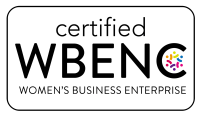Is your brand still working for you? Or is it drifting apart?
Your brand represents how people (including your prospects, clients, employees, and partners) perceive your business — good, bad, or indifferent. Keeping your brand aligned with your business strategy, culture, and target audience and consistent across all marketing mediums is critical to building brand recognition and reaching your objectives. In fact, according to Forbes, presenting a brand consistently across all platforms can increase revenue by up to 23%. Now that’s an incentive.
The challenge is that alignment and consistency can drift with time. When you’re focused on growing your business, it can be easy to lose sight of how well your brand is adapting with change. If your brand is no longer representing your business or resonating with your audience, it’s time to consider a brand refresh or a full rebranding campaign.
What is the difference between a brand refresh and a rebrand?
A brand refresh is a reinvigoration of your brand, while a rebrand is a complete overhaul of your brand identity.
Think of it as two recently updated and very desirable two-story homes on the market. One house had good bones but required some sprucing up. With some light renovations and upgrades — new paint, an updated kitchen, maybe even fresh landscaping to add curb appeal — it is refreshed and ready to welcome a new owner. The second house, a small single-story Cape Cod, was gutted and transformed (rebranded) into a multilevel home. It is now more in line with market demand.
Both two-story homes are now competitive in the market. The “rebranded” Cape Cod just took more time, money, and resources.
Brand Refresh
A brand refresh is more than just a logo redesign project. It involves tweaking your overall brand identity (sprucing it up). A brand refresh project plan may call for:
- Adjusting your marketing strategy
- Modifying or cleaning up your logo and visual identity
- Expanding your brand library with new elements
- Revising your messaging to reconnect with your audience
Rebrand
Rebrand means recreating your brand identity (gut and transform). Rebranding strategies can involve:
- Completely repositioning your brand to reach new audiences
- Defining a new marketing strategy
- Redesigning your logo and visual identity
- Reintroducing who you are by changing your brand story, messaging, and persona
How to decide if you need a brand refresh or a rebrand?
If you are unsure if you need a brand refresh or a full rebrand, a brand analysis can help determine the most effective course of action. A brand analysis, also known as a brand audit, provides an objective look at how well your brand performs. It includes:
- Discovery and Market Research. Understand your place in the market. Do your products or services still meet your customers’ needs? Are there new markets you could tap into?
- Customer Analysis. Confirm alignment with customers’ expectations. Are you targeting the right market segments? Are you marketing on the right platforms? Is your messaging still relevant?
- Competitive Analysis. Gauge how you compare to the competition. When was the last time you checked in on your competition? Are you at risk of losing ground to savvier strategies? How can you best differentiate from your customers?
Think about your brand. Have you outgrown it? Does it tell your story? Is it practical to use across different marketing mediums? Does it inspire your clients?
A brand analysis is crucial to answering questions like these. It ensures any changes made to your brand are based on strategy, rather than on anecdotes or assumptions. It is the key to building a better-positioned brand, whether through a refresh or a full overhaul.
What are the top 3 considerations for a successful brand refresh or rebrand?
No brand lasts forever. Every brand needs to evolve. To keep pace with your competitors and meet the changing needs and preferences of your audience, consider the following:
- Keep it adaptable. Ensure your brand is flexible, expandable, and agile. To keep your brand relevant over time, it needs to be responsive to today’s needs and ready for tomorrow.
- Keep it consistent. Visual consistency makes brands memorable. To achieve consistency, you need to think big — across digital platforms, signage, vehicle wraps, collateral, and anywhere else stakeholders will encounter your brand. But you also need to sweat the details, right down to the email signatures used by your staff. If your budget requires you to slow-walk your rollout, start with the most visible components, such as your primary web pages and social media platforms. Stick to a set of brand guidelines to build in consistency from the start.
- Don’t break it. Don’t change your logo or any other critical part of your brand on a whim. Do your research or talk to an expert before you start tweaking. All decisions about your brand should be based on strategy to avoid doing more harm than good.
We’re here to help! Our strategists can help you decide if a rebrand or a brand refresh is right for you. Or, contact us if you’re ready to start and want a branding partner to guide you through the process. View our work to see some of our successful branding examples.

